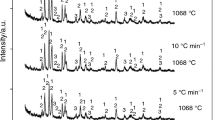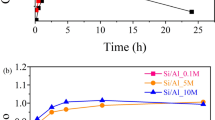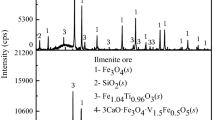Abstract
More than 40 samples of Al precipitation products formed in the presence of organic (aspartic, oxalic, citric, tartaric, malic, salicylic, and tannic acid, and acetylacetone) and inorganic (chloride, sulfate and phosphate) ligands, which were short-range-ordered materials after 2–5 months of aging, were analyzed by X-ray diffraction (XRD), infrared spectroscopy (IR), and transmission electron microscopic (TEM) examination after prolonged periods of aging in the mother liquids (from 7–15 years). Noncrystalline materials were found after 7–10 years of aging in samples formed in the presence of citrate, tartrate, and tannate at pH ≤ 8.0 and at ligand/Al molar ratios (R) ranging from 0.05–0.1; they were found as well in the presence of phosphate and malate at ligand/Al molar ratios from 0.1–0.5. Poorly crystalline Al-oxyhydroxides (pseudoboehmite) without Al(OH)3 polymorphs were found in solutions with a wide range of pH (from 6.0–11.0) in the presence of tartrate, citrate, tannate, malate, salicylate, sulfate, and phosphate after 7–15 years. The crystallinity of these samples was indeed very poor. On the contrary, gibbsite formation was observed in samples formed at pH 7.0 or 8.0 in the presence of oxalate (R = 0.1 or 1.0), aspartate (R = 0.1 and 0.5), malate (R = 0.03 or 0.17), salicylate (R = 0.05), and in samples containing very high concentrations of chloride (R = 700 or 1000). Finally, the formation of gibbsite was promoted in the presence of montmorillonite, but some samples at pH ≤ 6.0 in the presence of citrate (R = 0.1), tartrate (R = 0.1), or tannate (R = 0.02 or 0.1) showed after 6 years of aging interstratification of OH-Al species in the interlayers of the clay mineral and complete lack of Al(OH)3 polymorphs.
Similar content being viewed by others
References
Aldcroft, D., Bye, G. C., and Hughes, C. A. (1969) Crystalline process in aluminum hydroxide gels. IV. Factors influencing the formation of the crystalline trihydroxides: J. Appl. Chem. 19, 167–172.
Barnhisel, R. I. and Bertsch, P. M. (1989) Chlorites and hydroxy-interlayered vermiculite and smectite: in Minerals in Soil Environments, J. B. Dixon and S. B. Weed, eds., Soil Sci. Soc. Amer., Madison, Wisconsin, 729–788.
Buondonno, A., Felleca, D., and Violante, A. (1989) Properties of organo-mineral complexes formed by different addition sequences of hydroxy-Al, montmorillonite, and tannic acid: Clays & Clay Minerals 37, 235–242.
Hsu, P. H. (1967) Effect of salts on the formation of bay erite vs pseudoboehmite: Soil Sci. 103, 101–110.
Hsu, P. H. (1973) Effect of sulfate on the crystallization of aluminum hydroxide from aging hydroxy-aluminum solutions: in Proc. Int. Congr. on Studies of Bauxite and Aluminum Oxides-Hydroxides (Nice, France), 3rd ed., J. Nicolas, Ed., ICSOBA, Imprimeries Reunies de Chambery, Chambery, France, 613–620.
Hsu, P. H. (1979) Effect of phosphate and silicate on the crystallization of gibbsite from OH-Al solutions: Soil Sci. 127, 219–226.
Hsu, P. H. (1989) Aluminum hydroxides and oxyhydroxides: in Minerals in Soil Environments, J. B. Dixon and S. B. Weed, eds., Soil Sci. Soc. Amer., Madison, Wisconsin, 331–378.
Hsu, P. H. and Bates, T. F. (1964) Formation of X-ray amorphous and crystalline aluminum hydroxides: Mineral. Mag. 33, 749–768.
Huang, P.M. (1988) Ionic factors affecting aluminum transformations and the impact on soil and environmental sciences: Advances in Soil Science 8, 1–78.
Huang, P. M. and Violante, A. (1986) Influence of organic acids on crystallization and surface properties of precipitation products of aluminum: in Interactions of Soil Minerals with Natural Organics and Microbes, P. M. Huang and M. Schnitzer, eds., SSSA Spec. Publ. 17, 159–221.
Kodama, H. and Schnitzer, M. (1980) Effect of fulvic acid on the crystallization of aluminum hydroxides: Geoderma 24, 195–205.
Kwong, N. K. K. F. and Huang, P. M. (1975) Influence of citric acid on the crystallization of aluminum hydroxides: Clays & Clay Minerals 23, 164–165.
Kwong, N. K. K. F. and Huang, P. M. (1979) Nature of hydrolytic precipitation products of aluminum as influenced by low molecular weight complexing organic acids, Proc 6th Int. Clay Conf. Oxford, England 1978, M. M. Mortland and V. C. Farmer, eds., 27, Elsevier, Amsterdam, 527–536.
Serna, C. J., White, J. L., and Hem, S. L. (1977) Anionaluminum hydroxide gel interactions: Soil Sci. Soc. Am. J. 41, 1009–1013.
Tettenhorst, R. and Hofmann, A. (1980) Crystal chemistry of boehmite: Clays & Clay Minerals 28, 373–380.
Violante, A. (1985) Effect of perturbing anions on the nature of short-range ordered precipitation products of aluminum: Miner. Petrogr. Acta 29-A, 371–379.
Violante, A. and Huang, P. M. (1984) Characteristics and surface properties of pseudoboehmites formed in the presence of selected organic and inorganic ligànds: Soil Sci. Soc. Am. J. 48, 1193–1201.
Violante, A. and Huang, P. M. (1985) Influence of inorganic and organic ligands on the formation of aluminum hydroxides and oxyhydroxides: Clavs & Clay Minerals 33, 181–192.
Violante, A. and Huang, P. M. (1989) Influence of oxidation treatments on surface properties and reactivities of short-range ordered precipitation products of aluminum: Soil Sci. Soc. Am. J. 53, 1402–1407.
Violante, A. and Huang, P. M. (1992) Effect of tartaric acid and pH on the nature and physicochemical properties of short-range ordered aluminum precipitation products: Clays & Clay Minerals 40, 462–469.
Violante, A. and Jackson, M. L. (1979) Crystallization of nordstrandite in citrate systems in the presence of mont-morillonite: in Proc. Int. Clay Conf. Oxford, 1978, M. M. Mortland and V. C. Farmer, eds., Elsevier, Amsterdam, 517–525.
Violante, A. and Jackson, M. L. (1981) Clay influence on the crystallization of aluminum hydroxide polymorphs in the presence of citrate, sulfate, or chloride: Geoderma 25, 199–214.
Violante, A., Palmieri, F., and Buondonno, A. (1989) Influence of temperature and aging on the development of order of Al-oxyhydroxides: TRA VA UX 19(22), 341–349.
Violante, A. and Violante, P. (1978) Influence of carboxylic acids on the stability of chlorite-like complexes and on the crystallization of Al(OH)3 polymorphs: Agrochimica 22, 335–343.
Violante, A. and Violante, P. (1980) Influence of pH, concentration and chelating power of organic anions on the synthesis of aluminum hydroxides and oxyhydroxides: Clays & Clay Minerals 28, 425–434.
Wefer, K. and Bell, G. M. (1972) Oxides and hydroxides of aluminum: in Aluminum Co. Am., Tech. Rep. No. 19, Alcoa Research Laboratories, 52 pp.
Author information
Authors and Affiliations
Rights and permissions
About this article
Cite this article
Violante, A., Gianfreda, L. & Violante, P. Effect of Prolonged Aging on the Transformation of Short-Range Ordered Aluminum Precipitation Products Formed in the Presence of Organic and Inorganic Ligands. Clays Clay Miner. 41, 353–359 (1993). https://doi.org/10.1346/CCMN.1993.0410311
Received:
Accepted:
Published:
Issue Date:
DOI: https://doi.org/10.1346/CCMN.1993.0410311




